一.ribbon
1.准备工作
启动eureka-server 工程;启动service-hi工程,它的端口为8762;将service-hi的配置文件的端口改为8763,并启动,这时你会发现:service-hi在eureka-server注册了2个实例,这就相当于一个小的集群。访问localhost:8761如图所示:
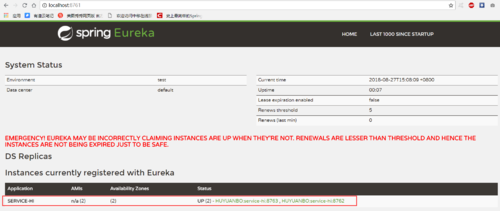
番外:IDEA启动多个工程实例(此处要用)

选择Edit Configurations

去掉右上角的Single Instance only(单实例)的对勾,此时便可以通过修改application.yml中的端口号来启动多个工程。
2.建一个服务消费者
新建一个spring-boot工程,取名为:service-ribbon; 在它的pom.xml文件分别引入起步依赖spring-cloud-starter-eureka、spring-cloud-starter-ribbon、spring-boot-starter-web
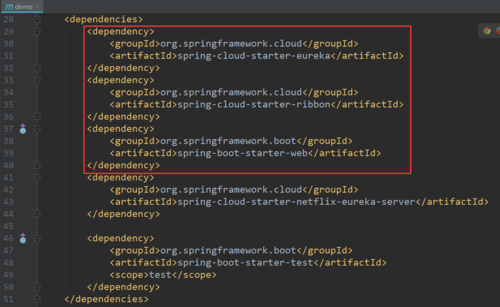
<dependency> <groupId>org.springframework.cloud</groupId> <artifactId>spring-cloud-starter-eureka</artifactId> <version>1.1.3.RELEASE</version> </dependency> <!-- https://mvnrepository.com/artifact/org.springframework.cloud/spring-cloud-starter-ribbon --> <dependency> <groupId>org.springframework.cloud</groupId> <artifactId>spring-cloud-starter-ribbon</artifactId> <version>1.1.3.RELEASE</version> </dependency> <!-- https://mvnrepository.com/artifact/org.springframework.boot/spring-boot-starter-web --> <dependency> <groupId>org.springframework.boot</groupId> <artifactId>spring-boot-starter-web</artifactId> <version>2.0.4.RELEASE</version> </dependency>
在工程的配置文件指定服务的注册中心地址为http://localhost:8761/eureka/,程序名称为 service-ribbon,程序端口为8764
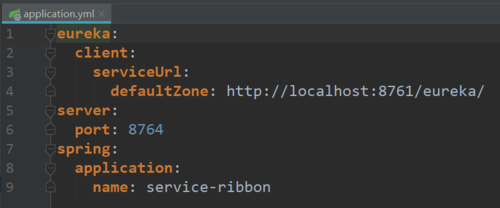
eureka: client: serviceUrl: defaultZone: http://localhost:8761/eureka/ server: port: 8764 spring: application: name: service-ribbon
工程的启动类中,通过@EnableDiscoveryClient向服务中心注册;并且向程序的ioc注入一个bean: restTemplate;并通过@LoadBalanced注解表明这个restRemplate开启负载均衡的功能。
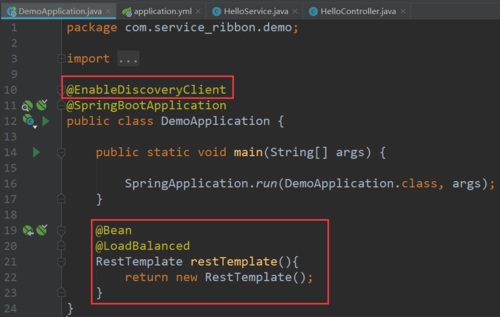
@EnableDiscoveryClient
@EnableHystrixDashboard
public class ServiceRibbonApplication {
public static void main(String[] args) {
SpringApplication.run(ServiceRibbonApplication.class, args);
}
@Bean
@LoadBalanced
RestTemplate restTemplate() {
return new RestTemplate();
}
}写一个测试类HelloService,通过之前注入ioc容器的restTemplate来消费service-hi服务的“/hi”接口,在这里我们直接用的程序名替代了具体的url地址,在ribbon中它会根据服务名来选择具体的服务实例,根据服务实例在请求的时候会用具体的url替换掉服务名

@Service
public class HelloService {
@Autowired
RestTemplate restTemplate;
@HystrixCommand(fallbackMethod = "hiError")
public String hiService(String name) {
return restTemplate.getForObject("http://SERVICE-HI/hi?name="+name,String.class);
}
public String hiError(String name) {
return "hi,"+name+",sorry,error!";
}
}写一个controller,在controller中用调用HelloService 的方法

@RestController
public class HelloController {
@Autowired
HelloService helloService;
@RequestMapping(value = "/hi")
public String hi(@RequestParam String name){
return helloService.hiService(name);
}
}在浏览器上多次访问http://localhost:8764/hi?name=forezp,浏览器交替显示:
hi forezp,i am from port:8762 hi forezp,i am from port:8763
这说明当我们通过调用
restTemplate.getForObject(“http://SERVICE-HI/hi?name=“+name,String.class)
方法时,已经做了负载均衡,访问了不同的端口的服务实例。
二.Feign
Feign是一个声明式的伪Http客户端,它使得写Http客户端变得更简单。使用Feign,只需要创建一个接口并注解。它具有可插拔的注解特性,可使用Feign 注解和JAX-RS注解。Feign支持可插拔的编码器和解码器。Feign默认集成了Ribbon,并和Eureka结合,默认实现了负载均衡的效果。
1.准备工作
启动eureka-server,端口为8761; 启动service-hi 两次,端口分别为8762 、8763.
2.创建一个feign的服务
新建一个spring-boot工程,取名为serice-feign,在它的pom文件引入Feign的起步依赖spring-cloud-starter-feign、Eureka的起步依赖spring-cloud-starter-eureka、Web的起步依赖spring-boot-starter-web,
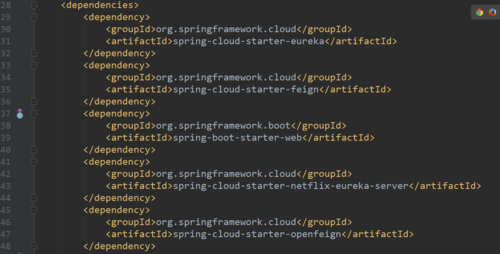
<dependency> <groupId>org.springframework.cloud</groupId> <artifactId>spring-cloud-starter-eureka</artifactId> <version>1.1.3.RELEASE</version> </dependency> <!-- https://mvnrepository.com/artifact/org.springframework.cloud/spring-cloud-starter-feign --> <dependency> <groupId>org.springframework.cloud</groupId> <artifactId>spring-cloud-starter-feign</artifactId> <version>1.3.0.RELEASE</version> </dependency> <dependency> <groupId>org.springframework.boot</groupId> <artifactId>spring-boot-starter-web</artifactId> </dependency> <dependency> <groupId>org.springframework.cloud</groupId> <artifactId>spring-cloud-starter-netflix-eureka-server</artifactId> </dependency> <dependency> <groupId>org.springframework.cloud</groupId> <artifactId>spring-cloud-starter-openfeign</artifactId> </dependency>
在工程的配置文件application.yml文件,指定程序名为service-feign,端口号为8765,服务注册地址为http://localhost:8761/eureka/

eureka: client: serviceUrl: defaultZone: http://localhost:8761/eureka/ server: port: 8765 spring: application: name: service-feign
在程序的启动类ServiceFeignApplication ,加上@EnableFeignClients注解开启Feign的功能
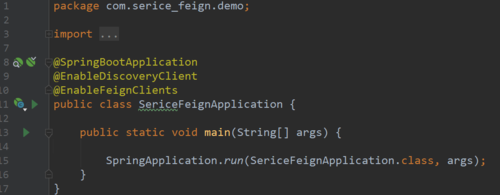
@SpringBootApplication
@EnableFeignClients
public class SericeFeignApplication {
public static void main(String[] args) {
SpringApplication.run(SericeFeignApplication.class, args);
}
}定义一个feign接口,通过@ FeignClient(“服务名”),来指定调用哪个服务。比如在代码中调用了service-hi服务的“/hi”接口,

在Web层的controller层,对外暴露一个”/hi”的API接口,通过上面定义的Feign客户端SchedualServiceHi 来消费服务。
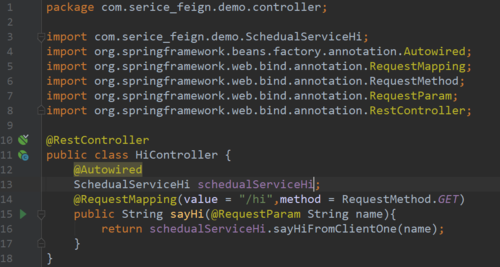
启动程序,多次访问http://localhost:8765/hi?name=forezp,浏览器交替显示:
hi forezp,i am from port:8762 hi forezp,i am from port:8763
以上便是两种服务的消费者ribbon+restTemplate和Feign,他们有什么区别呢?
Ribbon
是一个基于 HTTP 和 TCP 客户端的负载均衡器
它可以在客户端配置 ribbonServerList(服务端列表),然后轮询请求以实现均衡负载。
Feign
Spring Cloud Netflix 的微服务都是以 HTTP 接口的形式暴露的,所以可以用 Apache 的 HttpClient 或 Spring 的 RestTemplate 去调用,而 Feign 是一个使用起来更加方便的 HTTP 客戶端,使用起来就像是调用自身工程的方法,而感觉不到是调用远程方法。
简单来说就是feign是远程调用的,ribbon是做负载均衡的,feign发请求到哪是ribbon决定的,而且feign封装集成了hystrix和ribbon,支持负载均衡和熔断。
day2完毕,感谢大家阅读!
上一篇:一周学会Spring Cloud(Day1 服务的注册与发现)
下一篇:一周学会Spring Cloud(Day3 断路器 Hystrix和路由网关 zuul)
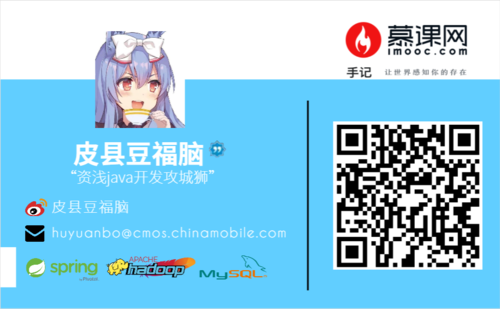


 随时随地看视频
随时随地看视频



